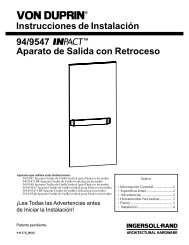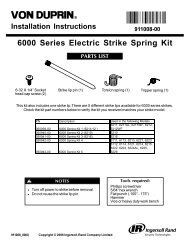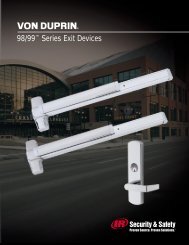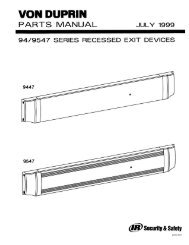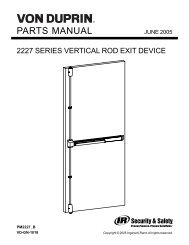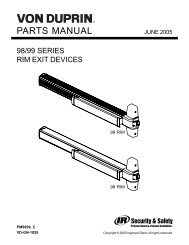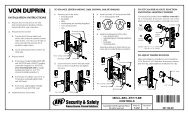Fire, Life Safety & Accessibility Codes - Von Duprin
Fire, Life Safety & Accessibility Codes - Von Duprin
Fire, Life Safety & Accessibility Codes - Von Duprin
You also want an ePaper? Increase the reach of your titles
YUMPU automatically turns print PDFs into web optimized ePapers that Google loves.
<strong>Fire</strong> Doors<br />
One of the cardinal rules of fire-rated doors is that they must be<br />
self-closing, but there are many ways to hold open a fire door<br />
(see figure 7). A wall- or floor-mounted magnetic holder and a<br />
separate mechanical closer may be used if the holder releases upon<br />
fire alarm. A closer with an integral electronic holder may either<br />
release upon fire alarm or may contain an integral smoke detector.<br />
For retrofit applications, a battery-operated holder with an integral<br />
smoke detector may be used in conjunction with a separate<br />
mechanical closer. According to NFPA 80, Standard for <strong>Fire</strong> Doors<br />
and <strong>Fire</strong> Windows, 2007 Edition:<br />
· 6.4.1 Closing Devices<br />
· 6.4.1.1* “Unless otherwise permitted by the AHJ, a closing device<br />
shall be installed on every fire door.”<br />
(Refer to Annex A for exceptions such as the inactive leaf of<br />
pairs of doors leading to unoccupied rooms as well as<br />
communicating doors between hotel rooms.)<br />
· 6.4.1.3. “All components of closing devices used shall be attached<br />
securely to doors and frames by steel screws or through-bolts.”<br />
· 6.4.1.4. All closing mechanisms shall be adjusted to overcome<br />
the resistance of the latch mechanism so hat positive latching<br />
is achieved on each door operation.<br />
· 6.4.1.5. “Where door holder/release devices are used,<br />
they shall be labeled.”<br />
· 6-1.4. Operation of Doors. All swinging doors shall be closed<br />
and latched at the time of fire.<br />
· 6.1.4.1For the purposes of 6.1.4,<br />
the operation of doors is divided into three categories:<br />
1. Self-closing doors<br />
2. Automatic-closing doors<br />
3. Power-operated fire doors<br />
· 6.1.4.2. Self-Closing Doors.<br />
· 6.1.4.2.1 Self-closing doors shall swing easily and<br />
freely and shall be equipped with a closing device<br />
to cause the door to close and latch each time it<br />
is opened.<br />
· 6.1.4.2.2 The closing mechanism shall not have a<br />
hold-open feature.<br />
· 6.1.4.3. Automatic Closing Doors. Automatic closing doors<br />
shall be permitted to close automatically by means of the<br />
installation of a closing device and one of the following:<br />
1.A separate, labeled, fail-safe door holder/release device<br />
or a hold-open mechanism that shall be permitted to be an<br />
integral part of the basic losing device<br />
2.An integral closing device that allows the door to swing<br />
freely and that automatically closes the door during an<br />
alarm condition provided the hold-open mechanisms are<br />
released by one or a combination of automatic fire<br />
detectors acceptable to the AHJ.<br />
877.840.3621 • www.securitytechnologies.ingersollrand.com<br />
· “6.1.4.4. Power Operated <strong>Fire</strong> Doors. Power operated fire doors<br />
shall be equipped with a releasing device that shall automatically<br />
disconnect the power operator at the time of fire, allowing a<br />
self-closing or automatic device to close the door regardless<br />
of power failure or manual operation.”<br />
<strong>Life</strong>-<strong>Safety</strong><br />
The 2006 Edition of NFPA 101® The <strong>Life</strong> <strong>Safety</strong> Code®,<br />
contains similar requirements:<br />
· 7.2.1.8. Self-Closing Devices.<br />
· 7.2.1.8. 1*A door normally required to be kept closed shall not be<br />
secured in the open position at any time and shall be self-closing<br />
or automatic-closing in accordance with 7.2.1.8.2. unless otherwise<br />
permitted by 7.2.1.8.3.<br />
· 7.2.1.8.2 In any building of low or ordinary hazard contents,<br />
as defined in 6.2.2.2 and 6.2.2.3, or where approved by the<br />
authority having jurisdiction, doors shall be permitted to be<br />
automatic-closing, provided that the following criteria are met.<br />
1. Upon release of the hold-open mechanism,<br />
the door becomes self-closing.<br />
2. The release device is designed so that the door instantly<br />
releases manually and, upon release, becomes self-closing,<br />
or the door can be readily closed.<br />
3. The automatic releasing mechanism or medium is activated<br />
by the operation of approved smoke detectors installed in<br />
accordance with the requirements for smoke detectors for<br />
door release service in NFPA 72, National <strong>Fire</strong> Alarm Code.<br />
4. Upon loss of power to the hold-open device, the hold-open<br />
mechanism is released and the door becomes self-closing.<br />
5. The release by means of smoke detection of one door in<br />
a stair enclosure results in closing all doors serving that stair.<br />
Note: Portions of some codes and standards have been reprinted here<br />
for your reference. For complete requirements, consult the applicable<br />
code publication.<br />
figure 8<br />
figure 7<br />
Note: Fusible link hold-open<br />
arms for door closers do not<br />
meet the requirements of<br />
NFPA 80 or NFPA 101 ®<br />
because they are not<br />
smoke-activated.<br />
(see figure 8)<br />
29



